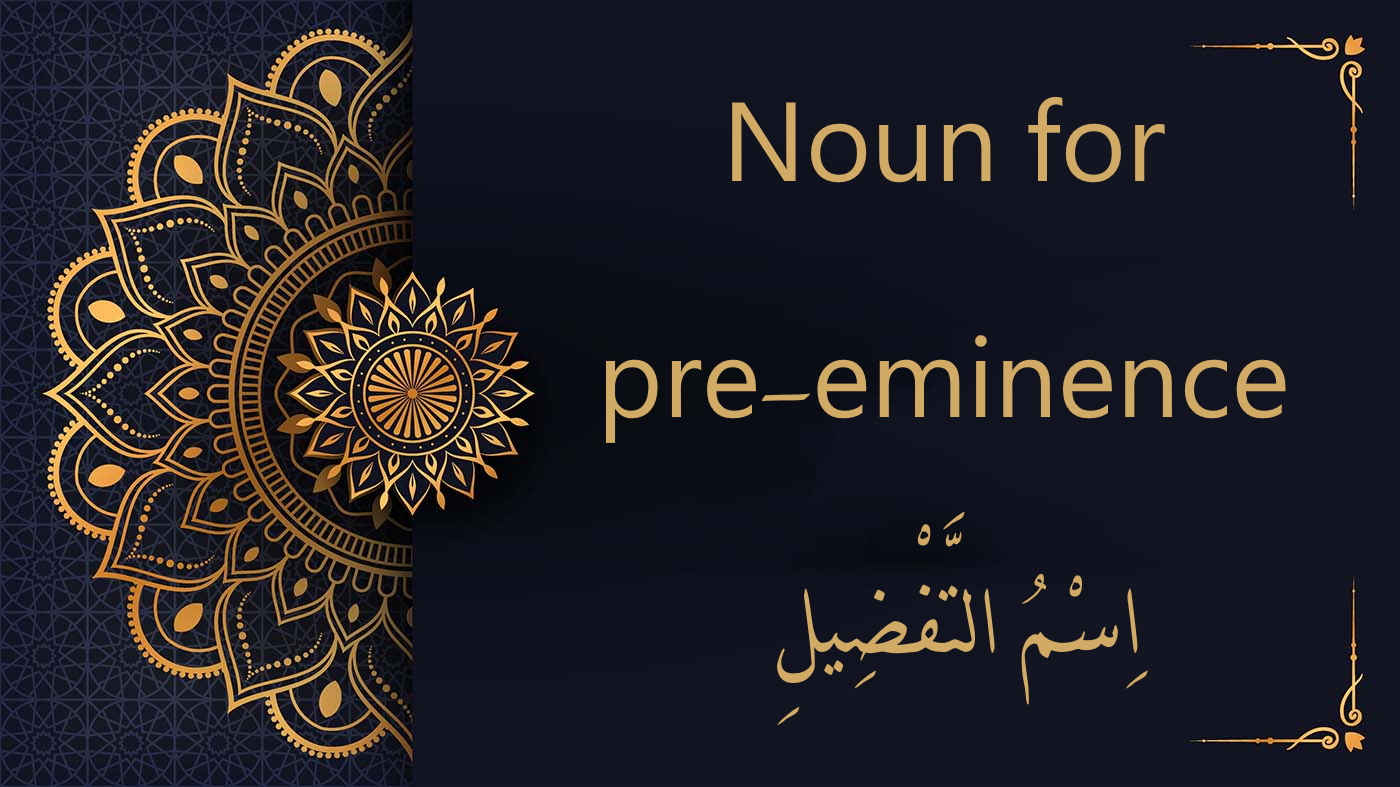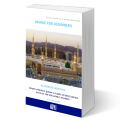
Noun for pre-eminence in Arabic - اِسْمُ التَّفْضِيلِ
Introduction
This noun is employed to establish a comparison between entities, be it between two individuals, objects, groups, or even comparing one individual to a group. Known as اِسْمُ التَّفْضِيلِ, the noun of pre-eminence comes in two forms:
- Comparative – اِسْمُ المُقَارِنِ
- Superlative – اِسْمُ التَّفْضِيلِ.
1. The comparative - اِسْمُ المُقَارِنِ
When comparing two nouns in Arabic, the superior noun is termed as المُقَضَّلُ, indicating it has a greater quality, quantity, or relation than the second noun, termed as المُفَضَّلُ عَلَيْهِ. The particle مِنْ is used for the comparison. The typical sentence structure follows this pattern:
المُفَضَّلُ عَلَيْهِ + مِنْ + اِسْمُ التَّفْضِيل + المُقَضَّلُ.
وَالْفِتْنَةُ أَكْبَرُ مِنَ الْقَتْلِ
And fitnah is greater than killing. (2:217)
In Arabic comparative sentences, مِنْ is employed, analogous to the use of “than” in English.
The structure for the noun of pre-eminence – اِسْمُ التَّفْضِيلِ is:
- Singular masculine: أَفْعَلُ
- Singular feminine: فُعْلَى
- Dual masculine: اَفْعَلانِ
- Dual feminine: فَعْلَيَانِ
- Plural masculine: فُعْلٌ
- Plural feminine: فُعْلٌ
These nouns, typically derived from a tri-radical root, share a pattern consistent with colors and defects. Here are a few examples:
- From حَبِيْبٌ (beloved), we get أَحَبُّ meaning ‘dearer’ or ‘more beloved’.
- From كَبِيرٌ (great), we derive أَكْبَرُ, which means ‘greater’.
While the feminine form of أَفْعَلُ is فُعْلَى, the masculine form, أَفْعَلُ, is often employed for feminine comparative adjectives.
Example:
إِنَّ نَاشِئَةَ اللَّيْلِ هِيَ أَشَدُّ وَطْئًا وَأَقْوَمُ قِيلً
Indeed, the hours of the night are more effective for concurrence [of heart and tongue] and more suitable for words. (73:6)
When either المُفَضَّلُ or المُفَضَّلُ عَلَيهِ appear in a sentence, whether they are singular, dual, or plural, the comparative adjective – اِسْمُ المُقَارِن will remain singular, following the pattern of أَفْعَلُ. For instance:
وَنَحْنُ أَقْرَبُ إِلَيْهِ مِنْ حَبْلِ الْوَرِيدِ
and We are closer to him than [his] jugular vein (50:16)
Comparative Examples from the Holy Quran
لَيْلَةُ الْقَدْرِ خَيْرٌ مِّنْ أَلْفِ شَهْرٍ
The Night of Decree is better than a thousand months. (97:3)
وَمَنْ أَحْسَنُ مِنَ اللَّـهِ صِبْغَةً
And who is better than Allah in [ordaining] religion? (2:138)
يَدْعُو لَمَن ضَرُّهُ أَقْرَبُ مِن نَّفْعِهِ
He invokes one whose harm is closer than his benefit (22:13)
2. The superlative - اِسْمُ التَّفْضِيلِ
Superlatives in Arabic highlight the utmost degree of comparison among individuals, animals, or objects, underscoring the preeminence of one over the others. To form the superlative, two primary techniques are employed:
The Noun of Pre-eminence, اِسْمُ التَّفْضِيلِ, becomes definite by adding the prefix ‘ال’. Its formation considers gender and number.
For instance: حَامِدٌ الأكْبَرُ – Hamid is the greatest. خَدِجَةُ الكُبْرَى – Khadijah is the foremost. الشُّهَدَاءُ الأَكَابِرُ – the most esteemed martyrs.
In Arabic, the Noun of Pre-eminence, اِسْمُ التَّفْضِيلِ, can also be expressed through a possessive construction. This method is particularly utilized when highlighting that the المُفَضَّلُ stands out in a specific quality among a group, whether they share that quality or possess different ones.
Examples:
وَأَنتَ أَحْكَمُ الْحَاكِمِينَ
and You are the most just of judges! (11:45)
وَهُوَ أَرْحَمُ الرَّاحِمِينَ
and He is the most merciful of the merciful.” (12:64)
وَهُوَ أَسْرَعُ الْحَاسِبِينَ
and He is the swiftest of accountants. (6:62)
In Arabic, the patterns for comparative and superlative forms typically stem from three basic radicals. For instance:
كَبِيرٌ becomes أَكْبَرُ, meaning ‘bigger’ صَغِيرٌ transitions to أَصْغَرُ, denoting ‘smaller’
However, for more complex words, especially those that deviate from the three-consonant structure, or those following the pattern of أَفْعَل, the comparative form is achieved using either أَكْثَرُ or أَشَدُّ. This is then paired with a noun in the accusative case.
Examples:
- أَبْيَضُ – white
- أَشَدُّ بَيْضَاء – whiter
وَالَّذِينَ آمَنُوا أَشَدُّ حُبًّا لِّلَّـهِ
But those who believe are stronger in love for Allah. (2:165)
أَنَا أَكْثَرُ مِنكَ مَالًا
I am greater than you in wealth (18:34)
3. The elative - اِسْمُ المُبَالَغَةِ
In the noun of pre-eminence, اِسْمُ التَّفْضِيلِ, the focus is on comparison between nouns. On the other hand, in the noun for emphasis, اِسْمُ المُبَالَغَةِ, the quality is inherent and possesses a heightened intensity, without making comparisons to others. For example:
وَأَنَّ اللَّـهَ عَلَّامُ الْغُيُوبِ
and that Allah is the Knower of the unseen? (9:78)
The elative forms are consistent for both masculine and feminine, though occasionally, “ة” (Ta marboota) is appended. Here are some representative patterns:
1. Pattern فَعْلانُ
Example: رَحْمَانُ – Most merciful
2. Pattern فَعِيلٌ
Example: طَاغُوْتٌ – tyrant
3. Pattern فُعْلانُ
Example: فُرْقَانُ – distinguisher
4. Pattern فِعِّيْلٌ
Example: صِدِّيْقٌ – most truthful
5. Pattern فَعُوْلٌ
Example: غَفُورٌ – most forgiving
6. Pattern فُعْلَةٌ
Example: هُمَزَةٌ – defamer
7. Pattern فَعَّالَةٌ
Example: عَلَّامَةٌ – most learned
8. Pattern فَاعِلَةٌ
Example: دَاعِيَّةٌ – caller (best), the summoner
9. Pattern فَعِلٌ
Example: فَرِحٌ – rejoicing one
10. Pattern مِفْعَالٌ
Example: مِحْرَابٌ – fighter
11. Pattern مِفْعِيلٌ
Example: مِنْطِيقٌ – most talkative
12. Pattern فُعَّالٌ
Example: كُبَّارٌ – most mighty
13. Pattern فَعُّوْلٌ
Example: قَيُّوْمٌ – best sustainer
14. Pattern فَعُّولٌ
Example: قَدُّوْسٌ – most holy
Examples of Elative Forms Found in the Holy Quran
وَمَكَرُوا مَكْرًا كُبَّارًا
And they conspired an immense conspiracy. (71:22)
إِنَّكَ أَنتَ عَلَّامُ الْغُيُوبِ
Indeed, it is You who is Knower of the unseen” (5:109)
إِنَّ هَـٰذَا لَشَيْءٌ عُجَابٌ
Indeed, this is a curious thing. (38:5)
إِنَّ اللَّـهَ هُوَ الرَّزَّاقُ ذُو الْقُوَّةِ الْمَتِينُ
Indeed, it is Allah who is the [continual] Provider, the firm possessor of strength. (51:58)
وَكَانَ الْإِنسَانُ عَجُولًا
and man is ever hasty. (17:11)
وَيْلٌ لِّكُلِّ هُمَزَةٍ لُّمَزَةٍ
Woe to every scorner and mocker (104:1)
وَكَانَ الشَّيْطَانُ لِلْإِنسَانِ خَذُولًا
And ever is Satan, to man, a deserter.” (25:29)
وَإِنِّي لَغَفَّارٌ لِّمَن تَابَ وَآمَنَ وَعَمِلَ صَالِحًا ثُمَّ اهْتَدَىٰ
But indeed, I am the Perpetual Forgiver of whoever repents and believes and does righteousness and then continues in guidance. (20:82)
اللَّـهُ لَا إِلَـٰهَ إِلَّا هُوَ الْحَيُّ الْقَيُّومُ
Allah – there is no deity except Him, the Ever-Living, the Sustainer of [all] existence. (2:255)
إِنَّ فِي ذَٰلِكَ لَآيَاتٍ لِّكُلِّ صَبَّارٍ شَكُورٍ
Indeed in that are signs for everyone patient and grateful (14:5)
إِنَّهُ سَمِيعٌ عَلِيمٌ
Indeed, He is Hearing and Knowing. (7:200)
Conclusion
This lesson on Arabic nuances concludes here. Insha’Allah, our subsequent session will delve into the number and its usage in Arabic.
Al-dirassa Institute invites you on a linguistic journey with our expert teachers to master the Arabic language. Should you wish to further your studies, we welcome your inquiries.
Chosen and Trusted by Thousands of Satisfied Learners
Discover the experiences of our delighted clients who have thoroughly enjoyed utilizing this standout feature.
Alhamdulillah I‘m very pleased with the arabic and Qur’an lessons I receive from teacher Umm Tasneem and I‘m also content with the al-dirassa administration team who were very quick in answering any questions I had. In a month I progressed a lot and I cannot wait to continue my studies with al-dirassa. May Allah reward everyone at al-dirassa.
 Verified review - view original
Verified review - view original
My Qur’an teacher is fantastic, she teaches me in a loving and kind way where I look forward to the lessons and learn so much. My Arabic teacher is equally as nice and has a lot of patience with me, she has great expertise in the field and I’ve progressed really quickly with her. Thank you Al-dirassa!
 Verified review - view original
Verified review - view original
Book your free trial lesson
Don’t want to go through the translation anymore?
30 free minutes with your qualified Egyptian teacher.




